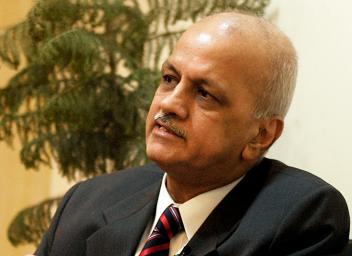NISG is a curious kind of public-private partnership in which the taxpayer is funding a private organisation
The national institute for smart government (NISG), envisioned as a prime mover of e-governance, is facing an identity crisis. Is it a private organision or a governmental one? Its equity has in effect more funds from the government, but it remains a private entity. That, however, has not stopped itself from depending on the government – for business or for grants.
The idea of creating an organisation like the NISG first came up in the 97th recommendation of the national taskforce on information technology and software development. The department of administrative reforms and public grievances (DAR&PG) and the department of information technology (DIT) then gave '5 lakh each to the National Association of Software and Service Companies (Nasscom) to prepare a feasibility report on NISG.
The Nasscom report estimated that '100 crore would be needed to establish the institute as a ‘section 25 company’, that is, a not-for-profit organisation with private-sector partnership. However, going by the records we accessed under the RTI Act, the high powered committee (HPC) headed by the secretary to the prime minister took the view that this centre for excellence in e-governance should be established under the aegis of an already existing institution like the IIT, Delhi or an IIM. This, according to the members of the committee, would bring down the cost to '10-12 crore.
The decision makers were very clear that if the private sector was funding such an institution the government should not be involved, and if the government was involved the institution had to be part of an existing institution of excellence and not a greenfield initiative. There was a suggestion that the NISG should be linked to the already existing National Informatics Centre (NIC).
The then joint secretary of DIT, Subir Hari Singh, after perusing the Nasscom report pointed out in his observations on April 11, 2001, “The role of Nasscom and local private industry is not very clear except that they are interested in the growth of software market.”
In a meeting under the chairmanship of Prodipto Ghosh, additional secretary in the prime minister office (PMO), the then secretary (IT) to the government of Andhra Pradesh (GoAP), R Chandrashekar said, “The institute will be conceptualised as a compact body with 15 specialists. The International Institute for Information Technology (IIIT) may act as mother institute and can provide infrastructure and manpower.” Chandrashekar has been at the helm of affairs of NISG since its conception as director in his capacity as joint secretary, DIT (he was later promoted as additional secretary, DIT and then as secretary, DIT).
However, in reality, the IIIT merely gave office space of 8,000 sq ft to NISG for initial years. Also the original idea of creating a compact and virtual organisation has also been defeated as there are close to 300 professionals on payrolls of NISG today. It has now become more like a manpower outsourcing agency than a centre of excellence.
A high powered committee (HPC) under the cabinet secretary on January 11, 2002 recommended that NISG may be established as a section 25 company. Chandrashekar, then joint secretary, DIT, GoI, was appointed officer on special duty (OSD) and a search committee was formed to select the CEO.
DIT within two months released '25 lakh to Nasscom for the institute, followed by another '75 lakh towards its share in the proposed equity of '1 crore in NISG. However, the then senior director of DIT, SS Grover had clearly mentioned in a note: “An amount of '1 crore has been released to NISG with the understanding that this will be converted into DIT’s share of equity in NISG on its formal registration.” NISG registered itself on May 28, 2002, and yet, the department’s equity in NISG stands at '41.77 lakh till date. This was confirmed in a reply to our RTI query.
Grover’s note stated that, “Both the internal finance division (IFD) of ministry of home affairs (MHA) and planning commission are not supporting the idea that the initial losses and corpus be met by government of India. All stakeholders should equally contribute towards corpus/ grants.” But different stakeholders contributing the same amount of funds got different amounts of equity. DIT, DAR&PG, GoAP and Nasscom contributed '1 crore each towards equity. Yet, DIT, DAR & PG and GoAP got '4,177,300 worth of equity each while Nasscom got '1 crore equity. The amount of '58,22,700 each contributed by DIT, DAR&PG and GoAP has been kept as excess share application money by NISG. Similarly, despite contributing '15 lakh the government of Assam has not been given any equity and the government of Chhattisgarh, government of Meghalaya and municipal corporation of Vizag were given equity worth '6,26,500 even after they contributed '15 lakh each. In this case too, the contribution of '8,73,500 each has been kept as excess share application money. Sources in NISG point out that this was done to ensure that the private sector equity remained at 51 percent despite government agencies’ contributions.
Grover’s note of December 12, 2003 said that the department of expenditure had advised DIT and DAR&PG to prepare a fresh cabinet note on NISG which should highlight that NISG would not require any further/recurring grant for GoI beyond the equity of '2 crore. However, DIT continues to give grants to NISG on one pretext or another.
It may be argued that NISG was giving offering its services and resources to DIT. However another note of DIT states that equity shareholders would be given full (the note originally said ‘free’ but the word was replaced with ‘full’ using white ink) access to NISG knowledge base and resources. So the question of NISG charging fee from DIT and taking additional grants does not arise. Also, the records point out that the fund flow to NISG was supposed to be pari passu with funds from private organisations so that the non-government character of the organization could be maintained.
One of the documents in DIT records makes a statement of intent that Nasscom will provide support worth '1 crore in kind with supply of hardware and software through industry members. The contribution in kind was not in line with the charter of NISG as in a communication to DIT, Geetha Nair, deputy director with DAR&PG, said, “To the extent possible equity support should not be in kind as the correct value of such contribution is difficult to discover.” However the actual mode of contribution of equity to NISG by Nasscom could not be verified as NISG did not commented on the above information which was sought under RTI Act.
Also, the cabinet approval number 16/CM/2005 clearly states, “The cabinet considered note dated 10.03.2005 from the ministry of personnel, public grievances and pensions and approved the proposal in para 10. The cabinet further directed that the contribution of private sector should be in cash.” The annexure 1 of the said cabinet note states that the government share in equity contribution to NISG should be at '4.9 crore and that of private partners '5.1 crore.
Another stakeholder, the government of Andhra Pradesh had promised five acres of land to NISG to ensure that the organisation was headquartered in Hyderabad. Initially some office space was given in the IIIT campus. But then the office space was taken back.
The issue of giving projects to NISG on nomination basis has also been highlighted in the official notes. DAR&PG in two letters dated December 11, 2003 and January 15, 2004 has stated that, “NISG should not get government business on a captive basis. As the skills and products being offered by NISG are available with other consultants, government business should go to NISG only on competition basis.” If the skills offered by NISG are available elsewhere in the private sector, what was the need to establish NISG in the first place?
Commenting on the NISG concept note, S Lakshminarayan, the then joint secretary, DIT, wrote to Nasscom president Kiran Karnik that, “We have examined your report on NISG and especially the annexure 2 which is relating to critical issues. Some of these issues / prerequisites like outsourcing of the projects strictly speaking are not in conformity with general government norms and may require detailed discussion.”
And yet NISG continues to get projects from the government on nomination basis. NISG has been advocating e-procurement in different government departments and has not yet adopted the same itself.
An organisation which was created to facilitate transparency in government has been operating in a non-transparent manner. The organisation has declared only limited information under the RTI Act and has failed to reply to RTI applications and appeals in many cases.
In reality, the government contribution in the NISG equity is '3.6 crore and the private sector’s stake is '1.5 crore. Thus, it is essentially a government organisation and should be under the purview of government rules on procurement, information disclosure and audit. It is strange that even after nine years of existence; NISG has not been able to bring more private sector investors on board. The lack of interest of private players in NISG clearly speaks of its rejection by the industry.

